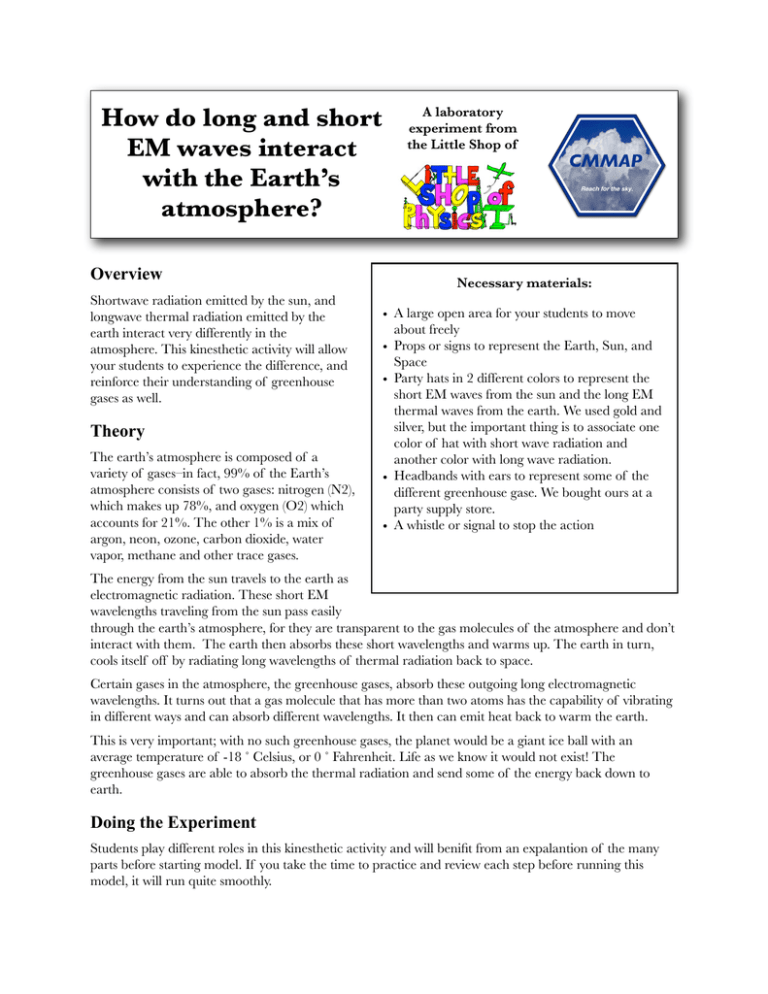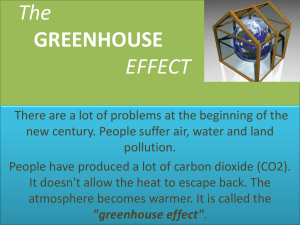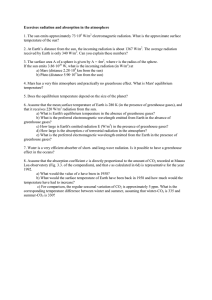How do long and short EM waves interact with the Earth’s atmosphere?
advertisement

How do long and short EM waves interact with the Earth’s atmosphere? Overview Shortwave radiation emitted by the sun, and longwave thermal radiation emitted by the earth interact very differently in the atmosphere. This kinesthetic activity will allow your students to experience the difference, and reinforce their understanding of greenhouse gases as well. Theory The earth’s atmosphere is composed of a variety of gases–in fact, 99% of the Earth’s atmosphere consists of two gases: nitrogen (N2), which makes up 78%, and oxygen (O2) which accounts for 21%. The other 1% is a mix of argon, neon, ozone, carbon dioxide, water vapor, methane and other trace gases. A laboratory experiment from the Little Shop of CMMAP Reach for the sky. Necessary materials: • A large open area for your students to move about freely • Props or signs to represent the Earth, Sun, and Space • Party hats in 2 different colors to represent the short EM waves from the sun and the long EM thermal waves from the earth. We used gold and silver, but the important thing is to associate one color of hat with short wave radiation and another color with long wave radiation. • Headbands with ears to represent some of the different greenhouse gase. We bought ours at a party supply store. • A whistle or signal to stop the action The energy from the sun travels to the earth as electromagnetic radiation. These short EM wavelengths traveling from the sun pass easily through the earth’s atmosphere, for they are transparent to the gas molecules of the atmosphere and don’t interact with them. The earth then absorbs these short wavelengths and warms up. The earth in turn, cools itself off by radiating long wavelengths of thermal radiation back to space. Certain gases in the atmosphere, the greenhouse gases, absorb these outgoing long electromagnetic wavelengths. It turns out that a gas molecule that has more than two atoms has the capability of vibrating in different ways and can absorb different wavelengths. It then can emit heat back to warm the earth. This is very important; with no such greenhouse gases, the planet would be a giant ice ball with an average temperature of -18 ˚ Celsius, or 0 ˚ Fahrenheit. Life as we know it would not exist! The greenhouse gases are able to absorb the thermal radiation and send some of the energy back down to earth. Doing the Experiment Students play different roles in this kinesthetic activity and will benifit from an expalantion of the many parts before starting model. If you take the time to practice and review each step before running this model, it will run quite smoothly. Sun, Earth, & Space Gather your students in a large open area so they can spread out as needed. Choose one student to represent the sun, another to represent space, and another to represent the earth. Give them signs or props so the rest of your class knows what role each of these students is portraying. Have the sun and earth stand on opposite ends of the large open area with space somewhere beyond the sun. The Atmosphere The sun is positioned on the opposite end of a large open area from teh earth. that represent carbon dioxide or water vapor wear headbands with ears on them to help simulate the number of atoms in the molecule. For carbon dioxide, the student’s head is symbolizing carbon, and the two ears on the headband represent oxygen. For water vapor, the student’s head symbolizes oxygen and the ears on the headband represent hydrogen. Have them spread out in the area between the earth and the sun, but put all the water vapor in the lower atmosphere closest to the earth. Have carbon dioxide there as well, but also some can be a bit higher in the atmosphere. Greenhouse gases will let the short waves by, Remind students that most of the atmosphere (99%) is made up of 2-atom molecules of nitrogen, N2, and oxygen, O2, but that 1% of the atmosphere is composed of trace gases, some of which are greenhouse gases. Now choose several of your students to represent greenhouse gases. We have our students Greenhouse gases spread out in the atmosphere near the earth. without interacting. When the long wave radiation from the earth passes by, each greenhouse gas will interact with every other one coming directly toward them, and send them back towards the earth. To interact, greenhouse gases should put their hands up at shoulder height and press their hands to the long wavelength’s hands, moving hands around for a few seconds like dancing. Then let go giving them a push back to the lower atmosphere and earth. Short wave radiation from the sun moves energetically through the atmosphere. Note that the greenhouse gases don’t interact with them. Short Wave Radiation from the Sun Explain to the rest of your class that they each get to act out two different wavelengths–the short wave radiation coming from the sun that warms the earth and then the long wave thermal radiation emitted by the earth that radiates to space, thus cooling the earth. The short wavelengths from the sun and the long wavelengths from the earth behave very differently. Have them practice being short wavelengths by moving their arms and legs quickly and taking a lot of tiny but fast steps. Then have them practice long wavelengths by acting like they are in slow motion as they move very slow and deliberate. The student has changed hats. The energetic radiation from the sun has been absorbed by the earth and now thermal radiation is emitted by the earth. Run the “Long and Short of It” Kinesthetic Model It is suggested that you have a practice run of the activity, following the directions below, with just one or two students as wavelengths, so your other students in the class can observe before participating in the model with everybody. Note that the students are moving in slow motion to simulate the thermal radiation emitted by the earth. wavelengths radiating from the sun. One by one they will travel through the atmosphere as they practiced, acting out very energetic radiation from the sun. They will travel past the greenhouse gases, without interacting with them. Once they get to earth, they will press into it (the sign or globe), simulating that they are absorbed by the earth. They then exchange their gold hat for a silver one, indicating that they are now long wave thermal radiation from the earth. They should move slowly as practiced through the atmosphere and out toward space. Now they will most likely have chances to interact with greenhouse gases. It they are directly in the path of a greenhouse gas, the gas may press his/her hands against the long To start the activity, have your students line up behind the sun and have them each put on a gold party hat to symbolize that they are short The greenhouse gas interacts with the long wavelength emitted by the earth. Be sure to stop the action throughout the activity so students can have time to observe and discuss the concentration of longwave thermal radiation. Summing Up This is a great activity to do after What makes a gas a greenhouse gas? and How does the atmosphere help keep the earth warm? You may want to discuss the importance of the interactions of the thermal radiation with the greenhouse gases. What would the world be like if the greenhouse gases didn’t interact with the thermal radiation? What is happening now with more greenhouse gases in the atmosphere? Your class could suggest changes with the model and try them out to illustrate these two scenarios. For More Information CMMAP, the Center for Multi-Scale Modeling of Atmospheric Processes: http://cmmap.colostate.edu Little Shop of Physics: http://littleshop.physics.colostate.edu








